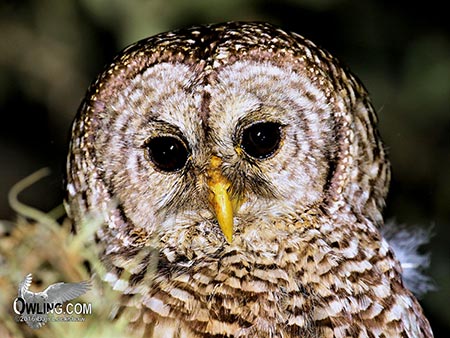
Barred Owl
A Reference for North and Central American Owls
The Barred Owl’s range is expanding west, now all the way to the north-west coast of North America, where it is slowly displacing its slightly smaller resident cousin, the Spotted Owl. Here you will find photos, recordings and a brief field notes section to help identify and enjoy this beautiful owl. A brief comparison of the Spotted and Barred Owls is given in the field notes tab below to help separate the two similar owls in the field.
A more in depth write up can be found in its natural history page.
To jump immediately to any of these sections use the Page Tabs below.
This is the territorial call (male). Both male and female give this call. The female’s voice is a higher pitch.
Male and female territorial calls. This set begins with the lower pitch male call and then is joined by the higher pitch female.
This set is both a male and female calling. The beginning of the set is dominated by a female’s territorial challenge call.
FIELD NOTES
Barred Owl – Strix varia
Barred Owl and Spotted Owls are very similar in appearance. In our field notes section here we briefly compare these two species to help you quickly distinguish the two owls in the field. There is an increasing range overlap between these two species as the slightly larger and more aggressive Barred Owl is displacing the Spotted Owl in the west. A more in depth species specific write up of the Barred Owl can be found on in our biology section. As a “Field Notes” section goes, these are the basics you should know to distinguish and or differentiate these two species in the field.
Visual Comparison
The Barred Owl is similar in appearance only to the Spotted Owl and is unlikely to be confused with any other owl. There are some distinct differences that make these two owls distinguishable though. The most visual distinction is that the Barred Owl has brown vertical streaks on its underside where the Spotted Owl has short brown horizontal bars (and spots on its crown). Barred Owl also has a distinctive sharp break between its vertical chest and flank streaks and lateral throat barring. Somewhat appears like the Barred Owl is wearing a scarf. It is also a lighter brown color overall and slightly larger (if they happen to be sitting next to each other this is quite noticeable!).
Vocalizations
Both Spotted and Barred Owls have bold calls in the forests but they are significantly different. The primary territorial location or advertisement call for the Barred Owl is often described as “Who cooks for you; Who cooks for you all?” or “You cook today; I cook tomorrow” (most noticeable is tone and pattern since the two owls have many variations). Male and female Barred Owl vocalizations can be found on the Audio Recordings tab.
Basic Identification
Eyes (or iris) of both the Spotted and Barred owls are dark brown to black, the bills are horn to yellowish in color and they lack ear tufts. The sexes are alike in appearance although males and females can be distinguished by call (female having a higher pitch). Length of the Barred Owl is 21″ (slightly shorter in length than a Red-tailed Hawk).
